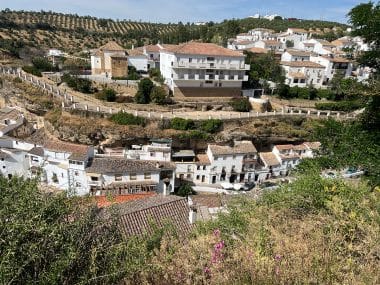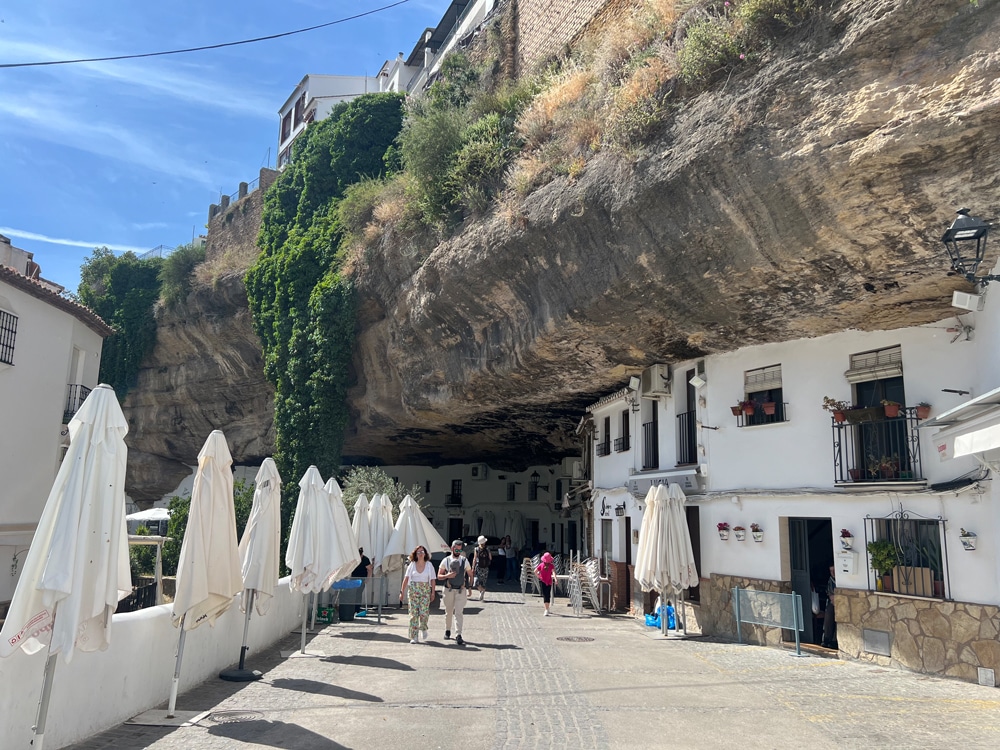Setenil de las Bodegas, a small village in the Spanish region of Andalusia, is one of the famous “Pueblos Blancos” (white villages) and impresses with its unique architecture. The special feature: Many of the houses are built directly into rock or covered by huge rock overhangs. This charming village offers a mixture of history, fascinating architecture and Andalusian lifestyle. Here you can find out why Setenil de las Bodegas is an absolute highlight for travelers in southern Spain.
A city under the rocks: Setenil’s unique construction
Setenil de las Bodegas is known for its extraordinary architecture. The village is nestled in a narrow gorge of the Trejo River, and many of the houses are built directly into the rocks. The inhabitants have managed to harmoniously integrate the natural landscape into their construction, which gives the place its special character. Particularly impressive are Calle Cuevas del Sol and Calle Cuevas de la Sombra, where the buildings are covered by massive rock overhangs. The rocks serve not only as a roof, but also as natural insulation against heat and cold. These streets are among the most photographed places in the village and offer a unique backdrop for a walk.
History and cultural significance of Setenil

The history of Setenil de las Bodegas dates back to prehistoric times, when the first cave dwellers used the rocks as protection from the elements and enemies. Later, the village became an important fortress during the Moorish rule. The name “Setenil” is believed to derive from the Latin “septem nihil”, which means “seven times nothing” – a reference to the seven unsuccessful sieges of the city by Christian troops in the 15th century. The addition “de las Bodegas” (translated: the wine cellar) came about later, when the region became known for its wineries and olive groves. Even today, Setenil is famous for its olive oil production and other regional specialties.
Culinary highlights: tapas and local specialties
Setenil de las Bodegas is not only a feast for the eyes, but also a foodie’s paradise. The small tapas bars and restaurants located along the main streets and under the rock overhangs invite you to enjoy the culinary delights of the region. Typical dishes are chorizo al vino (sausage in wine sauce), morcilla (black pudding) and fresh olives from the area. An absolute must is the local cheese and the high-quality olive oil produced in the region. It goes well with a glass of the regional wine, which comes from the nearby vineyards. For a sweet finish, try a piece of pestiños, a traditional Andalusian pastry with honey, which is especially popular during the Easter season.
Sights and experiences in and around Setenil
In addition to the impressive rock houses, there are some sights in Setenil de las Bodegas that are worth visiting:
- Setenil Castle: The 13th-century Moorish fortress towers over the village and offers fantastic views of the surrounding area. From here, the impressive architecture of the village can be admired particularly well.
- The Church of Nuestra Señora de la Encarnación: This church was built in the 16th century in the Gothic-Mudejar style and houses some ornate altarpieces.
- Hiking and nature: There are numerous hiking trails around Setenil that lead through the hilly landscape and olive groves. Particularly recommended is a hike along the river Trejo, which crosses the village.
- Excursions in the area: Setenil is close to other famous Pueblos Blancos such as Ronda, Zahara de la Sierra and Grazalema. These villages are ideal for a day trip.
Setenil de las Bodegas – A village straight out of a fairy tale
Setenil de las Bodegas is a unique destination that boasts impressive architecture, history and authentic Andalusian charm. Whether you walk through the rocky streets, enjoy the culinary specialties or explore the surrounding nature, this extraordinary village will captivate you. A visit to Setenil de las Bodegas is an unforgettable experience and a must for anyone who wants to discover Andalusia.


